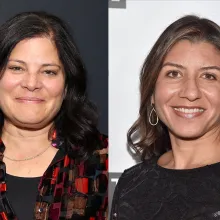The International Documentary Association (IDA) announced the appointment of Bonni Cohen and Jannat Gargi as new members of its Board of Directors.
Latest Posts
Essential Doc Reads is our curated selection of recent features and important news items about the documentary form and its processes, from around the internet, as well as from the Documentary magazine archive. We hope you enjoy! Following the cancellation of SXSW, The New York Times' Ben Sisario and Julia Jacobs assess the damage. Austin effectively canceled South By Southwest with declarations of disaster from Austin's mayor and Sarah Eckhardt, the Travis County judge, a position akin to chief executive of the county. Ms. Eckhardt said she signed a declaration disallowing festival gatherings
Psychologist Silvan Tomkins wrote about "the tendency of jobs to be adapted to tools, rather than adapting tools to jobs." The job of recording observational sound is unique in that being an empathetic presence is as important as being technically competent. Sound gear choices are too often made without concern for the nuances of this very social kind of filmmaking. If you are a solo shooter or have a creative partner instead of a professional doing sound, equipment choices have a considerable effect on your access, camerawork, available content and your ability to be either engaged or
From cover to cover, Say What Happened: A Story of Documentaries is, just like its author, Nick Fraser, a class act. Fraser is a formidable presence in the international documentary scene, with over 20 years as a top commissioning television editor. He created the BBC documentary strand Storyville in 1997 (its precursor on BBC, Fine Cut, was produced by André Singer), and oversaw it until 2016, when he left to found the streaming company now known as Docsville. In 2017 he suffered blood clots to the brain while giving a lecture and screening the film The English Surgeon, about the British
Subpoenas demanding that documentary filmmakers reveal confidential sources, or disclose their outtakes, notes or other unpublished work product pose a serious threat to the exercise of First Amendment rights. The risk of such compelled disclosure can chill communications with sources and film subjects, making them less likely to come forward or speak freely. And, in criminal matters, subpoenas run the risk of forcing investigative documentary filmmakers to act as an unwilling investigative arm of government, jeopardizing their independence. No documentary filmmaker wants to be forced to hand
What is the role of a documentary filmmaker in a country that has been largely devoid of images of itself on the big screen? Acclaimed Singaporean filmmaker Tan Pin Pin, who has tirelessly set her sights on the national identity of the Southeast Asian city-state, addressed this question, among many others, during her masterclass, which took place in the framework of last fall's International Leipzig Festival for Documentary and Animated Film ( DOK Leipzig). The festival also paid homage to Tan, featuring more than a dozen works from her oeuvre, assembled into four programs. Tan's adolescent
When the French multimedia artist, writer and nonfiction filmmaker Chris Marker died in 2012, the film world lost a seminal observer of us strange humans. I say "strange" with as much delight and generosity as Marker did in his films, of which there is perhaps no better example than in his remarkable essay film Le Joli Mai. Filmed during "the lovely month" of May 1962, Le Joli Mai is assembled mainly out of in-the-street interviews with a cross-section of "ordinary" Parisians, who are asked a variety of general questions about their lives, their relationships to work and the city, and their
It's tempting to take photos and excerpts of clips from seemingly non-professional sources that have been uploaded to YouTube and other internet sites, and use them in a documentary under the aegis of fair use. But is it legal? As usual, the answer isn’t simple and depends largely on the nature of the clip, how much you're using, the purpose of your use, and to a degree, where the clip originally came from. Legality is not a given, even if the material has gone viral and other news organizations seem to be helping themselves without asking permission or paying a fee. Two case decisions that
Documentary filmmakers have to be ready for anything. As the saying goes, the minute you put down the camera, the most amazing thing happens. In order to stay nimble, I wear everything I need on my body, which is why I have two fanny packs! I’m hoping this becomes cool one day so people stop making fun of me. I use the Chrome one to hold all my camera gear like extra cards, batteries and tools, even a small lens. When it’s full, the top lies flat and I can rest my camera on it, and leverage shots from-the-hip. The second fanny pack is smaller and holds my personal items like phone, ID, money
In 2016 documentary filmmaker Senain Kheshgi was approached to make a series of short films in collaboration with Save The Children, Johnson & Johnson and Facebook. It would mark Kheshgi’s first foray into the world of branded entertainment. Initially Kheshgi, who had no experience directing branded content, was hesitant. Despite being an Emmy-nominated and Peabody Award-winning filmmaker, the director wasn’t sure she would be good fit in the branded community. "I was used to working as a one-woman show or with a very small group of people," explains Kheshgi, who has directed documentary
